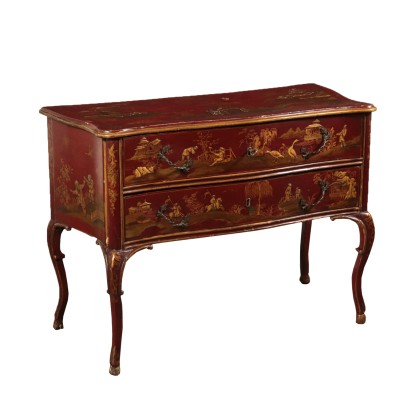Chest Of Drawers Lacquered Chinoiserie
Features
Style: Chinoiserie (1600-1800)
Age: 18th Century / 1701 - 1800
Origin: Piemonte, Italy
Main essence: Poplar
Material: Lacquer
Description
Mobile the piedmont dating back to the middle of the EIGHTEENTH century, in Baroque style, features the sides and the front moved back and the legs cabriolet; in poplar wood, with uprights in walnut. The door locks and the vents are consistent. The decoration in the chinoiserie with red lacquer and the figures in relief, gilded, dates back to the mid-NINETEENTH century. Scenes of rural life and the military, which recall, however, the exoticism of the east with river landscapes and architectures which recall the pagodas, and in fact can be found on the sides, on the two drawers of the front and also on the floor. Here, the scene is framed by a bezel, enhanced with floral motifs that recall those made on the posts. Lakes chinoiserie, in fact, were very popular in the mid-NINETEENTH century, as is demonstrated by the furniture of the famous “Sitting Japanese” (actually, of chinese inspiration) at the Palazzo del Quirinale in Rome, reconstructed in 1888 on the occasion of the first visit of the emperor William II.
Product Condition:
Product in good conditions, shows some signs of wear.
Maximum size (cm):
Height: 86
Width: 118
Depth: 52
Additional Information
Style: Chinoiserie (1600-1800)
The term Chinoiserie (Chinoiserie) derives from French and refers to a period of European art, starting from the seventeenth century, in which there was a considerable influence of Chinese art, also in the wake of a growing interest that Europe had developed for anything exotic in general.This period was characterized by the use of imaginative images of an imaginary China, by asymmetry in formats and capricious contrasts of scale and by attempts to imitate Chinese porcelain as well as by the use of materials similar to lacquer.
Chinoiserie entered the European repertoire in the second half of the 17th century, when the work of Athanasius Kircher had a great influence on the study of Orientalism.
The popularity of chinoiserie reached its peak in the mid-18th century, when they were assimilated into the Rococo by the works of François Boucher.
They then declined when they appeared, in the eyes of Europeans, antithetical to neoclassicism.
They expressed themselves entirely in the decorative arts while their expression in architecture was entirely realized in the field of capricious "follies" (constructions carried out exclusively for decorative purposes, but whose shape suggests another purpose).
On the other hand, the important transformations that the Chinese models carried out, in the 18th century, on the style of furniture of the early Georgian period and in the naturalistic style of the landscape of the English gardens, were not considered chinoiserie. Find out more about oriental influences in the history of the arts with our insights:
FineArt: Chinese mirror, last quarter of the 18th century
The oriental taste in the furnishings of late 19th century
The charm of the East in a factory Piedmontese
FineArt presentation of a 19th century Japanese armor

































